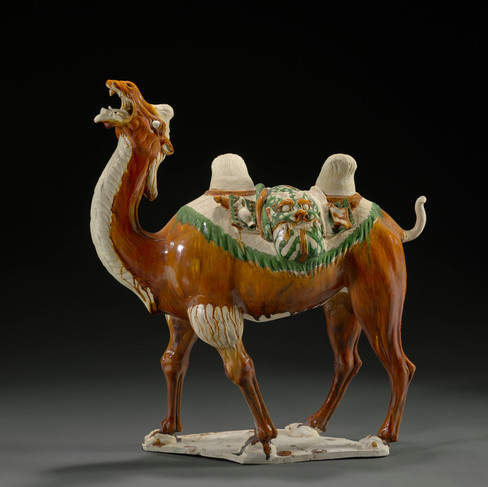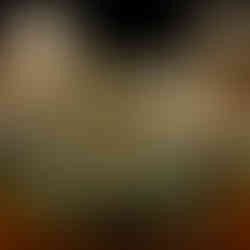拍賣筆記 vol.125 佳士得紐約:唐三彩駱駝,21.42萬美元售出 - A Tang Dynasty Massive And Well-Modeled Sancai-Glazed Pottery Figure Of A Bactrian Camel
- SACA
- Mar 21
- 4 min read

好的駱駝還是少見,這件非常精彩,尺寸巨大,這個價格物有所值。
紀柏堂珍藏
唐 三彩駱駝
TANG DYNASTY (AD 618-907)
成交價
美元 214,200
估價
美元 100,000 – 美元 150,000
33 in. (83.8 cm.) high
來源
1999年前入藏於香港

此件形體宏偉、造型精妙的陶製駱駝,是唐代八世紀上半葉上流社會墓葬隨葬俑中的典型代表作。此類俑像購置成本極高,通常被視作家族財富與地位的彰顯。因此,在唐代許多帝陵及貴族墓葬中,皆曾出土類似的駱駝俑。然而,這些駱駝俑不僅象徵財富,也暗示著這些財富可能來自絲綢之路上的商貿往來與朝貢關係。在唐代,駱駝確實如同其「沙漠之舟」之名,用於將絲綢等中國商品穿越絲路的嚴峻地形,運送到中亞、撒馬爾罕、波斯乃至敘利亞等地的市場。此外,駱駝亦可象徵唐代都城長安所呈現出的國際化氣象,因為牠們返程時所攜帶的正是唐代宮廷極為青睞的各種西域奢侈品。
中國早在漢代便已知曉雙峰的「大宛駝」(Bactrian camel),此物種最初由中亞和東突厥斯坦作為貢品傳入。由於駱駝極為耐受亞洲沙漠旅程的艱苦,朝廷不久即設立專門的部門管理皇家駝隊。此外,駱駝除了作為重要的運輸工具外,其毛髮也被用以織造出質輕而保暖的織物,備受推崇。

目前已知同尺寸與類型的唐代駱駝俑中,一件典型範例出自河南洛陽,著錄於《中國文物精華大全.陶瓷卷》(臺北,1993年,第155頁,編號534)。兩件作品皆有壯碩的身軀、生動邁步的姿態、極其精細的頭部刻畫(尤其是張嘴嘶鳴之姿)、寫實呈現頭頸部、臀部及駝峰的毛髮紋理,以及類似的釉彩配置。此外,兩者馱載的行囊中皆有一件施乳白釉的水壺。另一件尺寸和施釉方式均與本件相仿的邁步駱駝俑,現藏於舊金山亞洲藝術博物館,其上亦攜帶著類似的乳白釉水壺,且旁伴有一名牽駱駝的侍者,見華特森(W. Watson)著,《The Arts of China to AD 900》(中國藝術至公元900年),紐黑文/倫敦,1995年,第233頁,圖版37號。再有一件類似作品,藏於大英博物館,其釉色配置與本件及前述洛陽出土者相反,呈現乳白釉的駱駝身軀與琥珀棕釉的毛髮,著錄於《世界陶磁全集》第11卷(東京,1976年,第148頁,圖版136號)。
經英國牛津熱釋光(Oxford thermoluminescence)檢測(檢測編號PH 993/353),本件作品之年代與所述唐代斷代相符。

Property from the Hall In Memory Of Cypress (Jibo Tang)
A MASSIVE AND WELL-MODELED SANCAI-GLAZED POTTERY FIGURE OF A BACTRIAN CAMEL
TANG DYNASTY (AD 618-907)
Price realised
USD 214,200
Estimate
USD 100,000 – USD 150,000
33 in. (83.8 cm.) high
PROVENANCE
Acquired in Hong Kong, 1999.
This massive and exceptionally handsome camel is a particularly fine example of the type of figure that was made to go in the tombs of the Tang elite in the first half of the 8th century. Such models, which would have been very expensive to purchase, provided an obvious indication of the wealth of a family. Not surprisingly, camels have been found among the burial items in a number of the Tang imperial tombs, as well as some of those belonging to other members of the Tang nobility. However, these models were not simply symbols of wealth, they were also symbols of the way that wealth might have been acquired through trade and tribute along the Silk Route. In the Tang dynasty, camels really did live up to the description of them as 'ships of the desert' and were used to transport Chinese goods, including silk across the difficult terrain of the Silk Route to the eager markets of Central Asia, Samarkand, Persia, and Syria. They may also be seen as symbolic of the cosmopolitanism of the Tang capital at Chang'an. They carried, on their return journeys, many of the exotic luxuries from the west that were desired by the sophisticated Tang court.
The two-humped Bactrian camel was known in China as early as the Han dynasty, having been brought from central Asia and Eastern Turkestan as tribute. Its amazing ability to survive the hardships of travel across the Asian deserts was soon recognized and Imperial camel herds were established under the administration of a special bureau. Camels were not only prized as resilient beasts of burden, their hair was also used to produce a cloth which was admired for its lightness and warmth.
Of the known examples of camels of this size and type, one example is the figure from Luoyang, Henan, illustrated in Zhongguo wenwu jinghua daquan - taoci juan, Taipei, 1993, p. 155, no. 534. The two figures share the same massive size, striding pose, exceptionally well modeled head with the mouth open in a bray, realistic depiction of the hair on the head, neck, haunches and humps, and coloration. The depiction of the packs on the two are also quite similar including the inclusion of a cream-glazed ewer. A similar ewer can also be seen on the similarly glazed figure of a striding camel of comparable size to the present lot in the Asian Art Museum, San Francisco, which is shown with a groom, illustrated by W. Watson, The Arts of China to AD 900, New Haven/London, 1995, p. 233, no. 37. Another similar figure, in the British Museum, which has a reversal of the coloration of the present and the aforementioned figures from Luoyang, with the coat glazed cream and the hair glazed amber-brown, is illustrated in Sekai toji zenshu, vol. 11, Tokyo, 1976, p. 148, no. 136.
The result of Oxford thermoluminescence test no. PH 993⁄353 is consistent with the dating of this lot.
















Comments